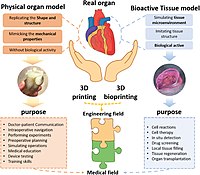
Photo from wikipedia
Three-dimensional (3D) bioprinting with suitable bioinks has become a critical tool for fabricating 3D biomimetic complex structures mimicking physiological functions. While enormous efforts have been devoted to developing functional bioinks… Click to show full abstract
Three-dimensional (3D) bioprinting with suitable bioinks has become a critical tool for fabricating 3D biomimetic complex structures mimicking physiological functions. While enormous efforts have been devoted to developing functional bioinks for 3D bioprinting, widely accepted bioinks have not yet been developed because they have to fulfill stringent requirements such as biocompatibility and printability simultaneously. To further advance our knowledge of the biocompatibility of bioinks, this review presents the evolving concept of the biocompatibility of bioinks and standardization efforts for biocompatibility characterization. This work also briefly reviews recent methodological advances in image analyses to characterize the biocompatibility of bioinks with regard to cell viability and cell-material interactions within 3D constructs. Finally, this review highlights a number of updated contemporary characterization technologies and future perspectives to further advance our understanding of the biocompatibility of functional bioinks for successful 3D bioprinting.
Journal Title: Bioengineering
Year Published: 2023
Link to full text (if available)
Share on Social Media: Sign Up to like & get
recommendations!